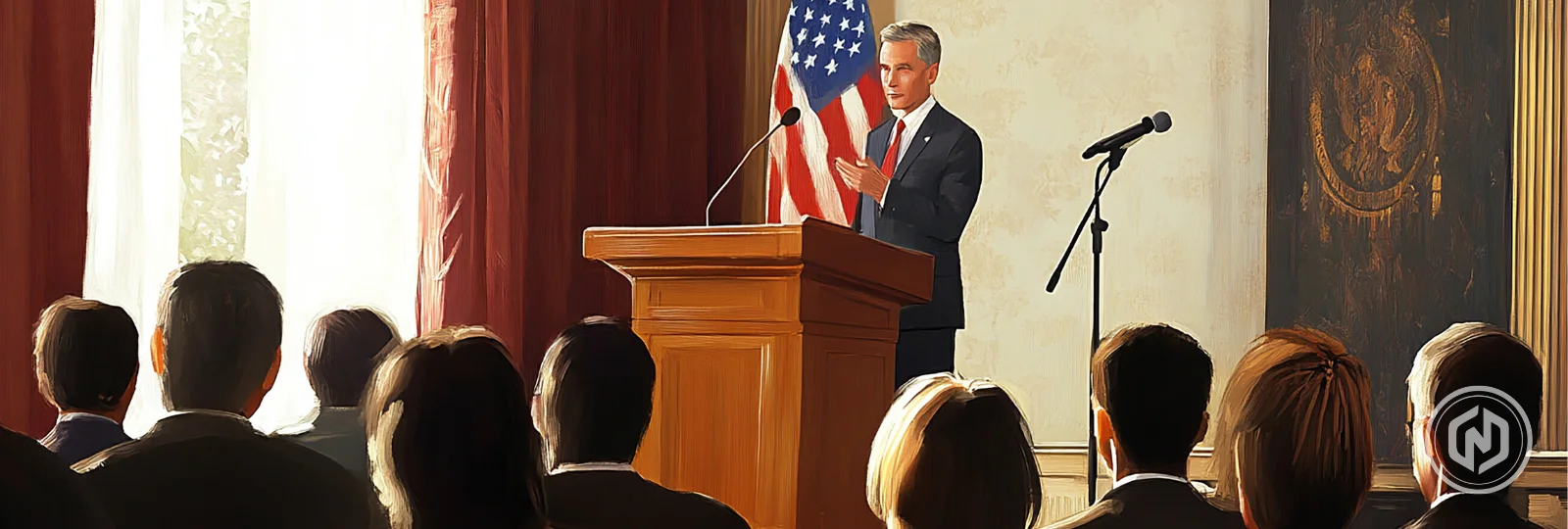Key Highlights
- The US Federal Reserve Board announced a Payments Innovation Conference on October 21
- In this conference, officials will discuss cryptocurrency, stablecoin, DeFi, and tokenization
- The conference will be publicly livestreamed
The US Federal Reserve Board will host a Payments Innovation Conference this October 21. The event will discuss the biggest ideas related to cryptocurrency, along with Stablecoins, DeFi, and tokenization, also all on the agenda.
@federalreserve announces it will host a conference on payments innovation on Tuesday, October 21: https://t.co/XnhqinMlwO
— Federal Reserve (@federalreserve) September 3, 2025
This is not a casual academic discussion, as it is a strategic move amid regulatory shift under U.S. President Donald Trump’s presidency. It shows the Fed’s serious intent to understand digital assets.
The conference, led by Fed Governor Christopher J. Waller, will be publicly livestreamed. This openness is a stark change from the Fed’s historically hostile stance.
Governor Christopher J. Waller said, “Innovation has been a constant in payments to meet the changing needs of consumers and businesses. I look forward to examining the opportunities and challenges of new technologies, bringing together ideas on how to improve the safety and efficiency of payments, and hearing from those helping to shape the future of payments.”
In April, the Fed, FDIC, and OCC withdrew restrictive 2022 guidance. That old policy required banks to get approval for crypto activities. They needed a green light for things like holding crypto or issuing stablecoins.
Now, that barrier is gone. Banks can innovate more freely. Oversight will come through routine exams. This hands-off approach aligns with a broader political push. The current administration wants the U.S. to lead in crypto.
So, what’s on the table of the Federal Reserve for October?
Stablecoins will be at the focus of the discussion of the Federal. These are digital dollars pegged to the U.S. currency. These digital currencies are known for faster, cheaper payments. The conference will explore their potential role.
Decentralized finance (DeFi) is another topic. This system offers lending and trading without banks. It runs on automated blockchain code.
Tokenization will also be discussed. This is the process of turning real assets into digital tokens. One can think of it as owning a piece of a building through a digital token. It could revolutionize investing.
Artificial intelligence’s role in payments rounds out the agenda. AI could make transactions smarter and safer.
Crypto’s Fate In the Banking Sector Will Be Discussed
This discussion is a big deal for traditional finance. For years, big banks avoided crypto due to regulatory uncertainty. That fear is now fading. The Fed is inviting “new entrants” to the payments system.
Market analysts are paying attention. Past Fed comments on stablecoins moved markets. This event could do the same. It may accelerate the adoption of crypto infrastructure.
But it’s not all bullish excitement. The Fed’s announcement was notably low-key. Some law firms noted its quiet tone. This suggests internal debates may still be raging.
Regulators are clear on one point. Innovation must not come at the expense of safety. The FDIC and Fed issued a joint statement. They reminded banks that existing rules still apply. Consumer protection and anti-money laundering laws are non-negotiable.
For the average person, this shift could bring real benefits. International money transfers could become instant. Fees could plummet. New investment opportunities might emerge.
Crypto markets surged 10% after April’s regulatory easing. Investor confidence grew with clearer rules. However, critics warn that tokenization could increase volatility. Poor regulation might lead to systemic risk. We saw this in the 2022 crypto crashes.
Macroeconomic factors also play a role. The Fed is still fighting inflation. If price pressures persist, interest rate cuts may be delayed. This could cool investor enthusiasm for crypto.
The political landscape adds another layer. The Fed’s independence is a topic of debate. Presidential influence on crypto policy is growing. This introduces uncertainty.
Looking ahead, this conference is more than a talk shop. It could shape legislation. Congress is already debating stablecoin rules. The Federal’s findings could inform new laws by 2026.
Vice Chair Michelle Bowman has advocated for “direct experience” with crypto. This conference is a step toward that goal. It favors collaboration over confrontation.
After years of a hostile stance, the Fed is finally engaging with crypto. It is moving from skepticism to structured dialogue. This is a pivotal moment for the U.S. financial system. Markets will watch October’s event closely. It could define the next decade of finance.



